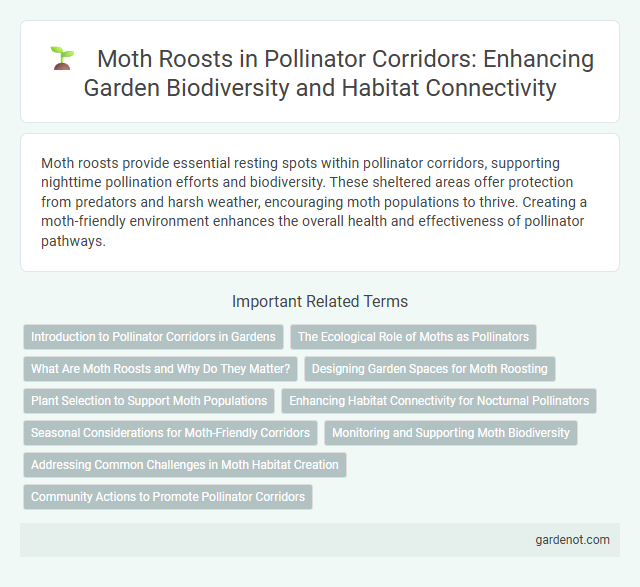Moth roosts provide essential resting spots within pollinator corridors, supporting nighttime pollination efforts and biodiversity. These sheltered areas offer protection from predators and harsh weather, encouraging moth populations to thrive. Creating a moth-friendly environment enhances the overall health and effectiveness of pollinator pathways.
Introduction to Pollinator Corridors in Gardens
Moth roosts within pollinator corridors provide essential nighttime shelter that supports the survival and diversity of moth populations, which are key nocturnal pollinators. Incorporating native plants that offer suitable roosting sites enhances garden ecosystems by promoting pollination and biodiversity. Pollinator corridors create continuous habitats, facilitating movement and feeding opportunities for moths and other vital pollinators throughout urban and suburban landscapes.
The Ecological Role of Moths as Pollinators
Moths serve as vital nocturnal pollinators within pollinator corridors, facilitating gene flow and biodiversity by transferring pollen between night-blooming plants. Their roosting behavior in sheltered areas supports energy conservation, enhancing their efficiency in pollination activities during nighttime. This ecological role reinforces plant reproduction and ecosystem health, contributing to sustainable habitats for various species.
What Are Moth Roosts and Why Do They Matter?
Moth roosts serve as essential resting and sheltering sites for moths during daylight hours, providing protection from predators and harsh weather conditions. These roosting locations support pollinator corridors by ensuring moth populations remain healthy and active, contributing to nocturnal pollination of various plants. Conserving moth roosts enhances biodiversity and stabilizes ecosystems dependent on moth-mediated pollination.
Designing Garden Spaces for Moth Roosting
Designing garden spaces for moth roosting involves incorporating dense shrubs, native plants, and tall grasses that provide shelter and protection from predators. Selecting night-blooming flowers with strong fragrances attracts moths, encouraging them to rest and feed comfortably. Integrating features like deadwood and leaf litter enhances habitat complexity, supporting diverse moth populations essential for pollinator corridors.
Plant Selection to Support Moth Populations
Selecting native night-blooming plants such as evening primrose, jasmine, and moonflower provides essential nectar sources that support moth populations within pollinator corridors. Incorporating diverse plant species with overlapping bloom times ensures continuous food availability for various moth species throughout their active periods. Integrating host plants like willow and oak supports larval development, promoting healthy moth populations and enhancing overall pollination dynamics.
Enhancing Habitat Connectivity for Nocturnal Pollinators
Moth roosts serve as critical nodes within pollinator corridors, providing essential shelter and resting sites that enhance habitat connectivity for nocturnal pollinators. By preserving and establishing roosting habitats adjacent to flowering plants, these corridors support moth populations vital for the pollination of night-blooming species. Effective integration of moth roosts within landscape planning facilitates gene flow and ecosystem resilience through increased nocturnal pollination activity.
Seasonal Considerations for Moth-Friendly Corridors
Moth roost design in pollinator corridors must account for seasonal behavior patterns, including migration and breeding cycles that peak in spring and fall. Incorporating native plant species that provide nectar and shelter throughout these critical periods enhances moth survival and pollination activity. Maintaining a diversity of host plants ensures continuous availability of resources, supporting moth populations year-round in the corridor ecosystem.
Monitoring and Supporting Moth Biodiversity
Moth roosts play a critical role in supporting pollinator corridors by providing essential habitats for nocturnal pollinators, enhancing biodiversity monitoring efforts. Regular monitoring using light traps and bait stations helps track moth population dynamics and species diversity, informing conservation strategies. Establishing native plant species rich in nectar and host plants within these corridors supports moth lifecycle needs and promotes ecological balance.
Addressing Common Challenges in Moth Habitat Creation
Creating effective moth roosts in pollinator corridors requires addressing challenges such as habitat fragmentation, light pollution, and lack of diverse host plants. Incorporating native plant species that provide suitable larval food sources and nighttime shelter enhances roosting success. Implementing dark sky practices reduces artificial light interference, promoting natural moth behavior and supporting sustainable populations.
Community Actions to Promote Pollinator Corridors
Community actions to establish moth roosts within pollinator corridors significantly enhance nocturnal pollination and biodiversity. Planting native flowering species that bloom at night provides essential habitats for moths, supporting their lifecycle and migration. Organizing local workshops and citizen science monitoring programs fosters awareness and engagement in maintaining and expanding these critical habitats.
Moth roost Infographic

 gardenot.com
gardenot.com